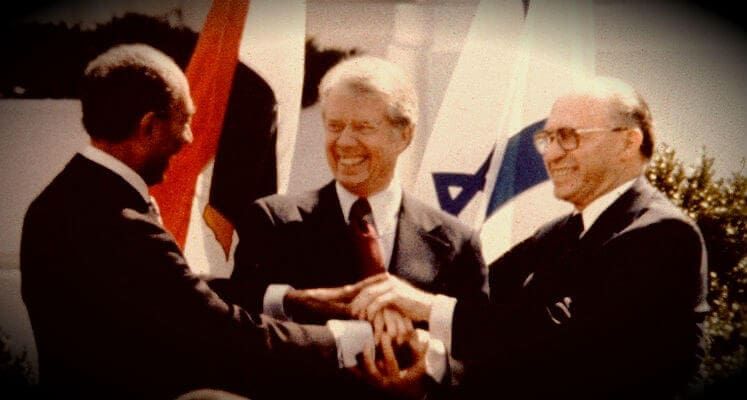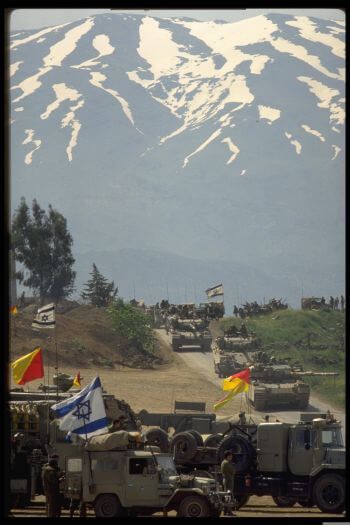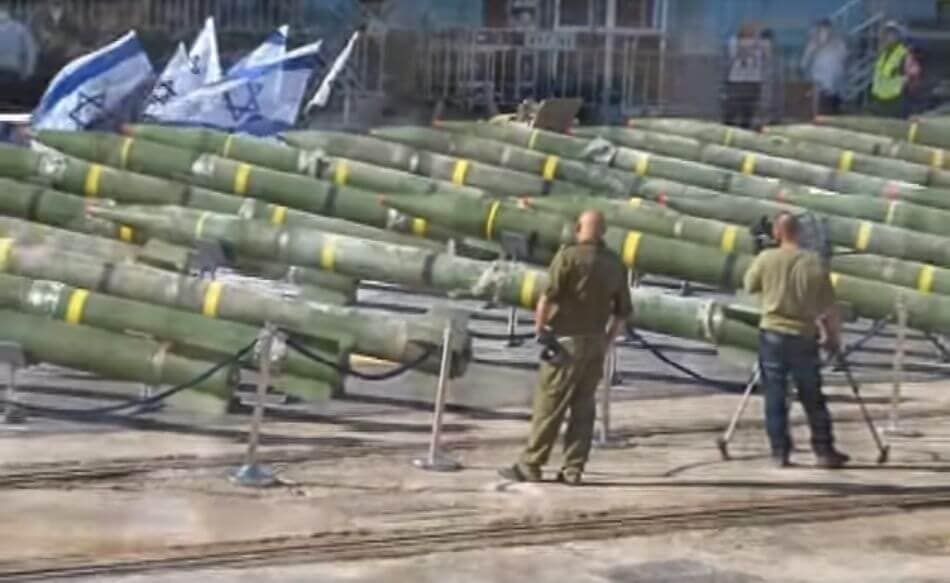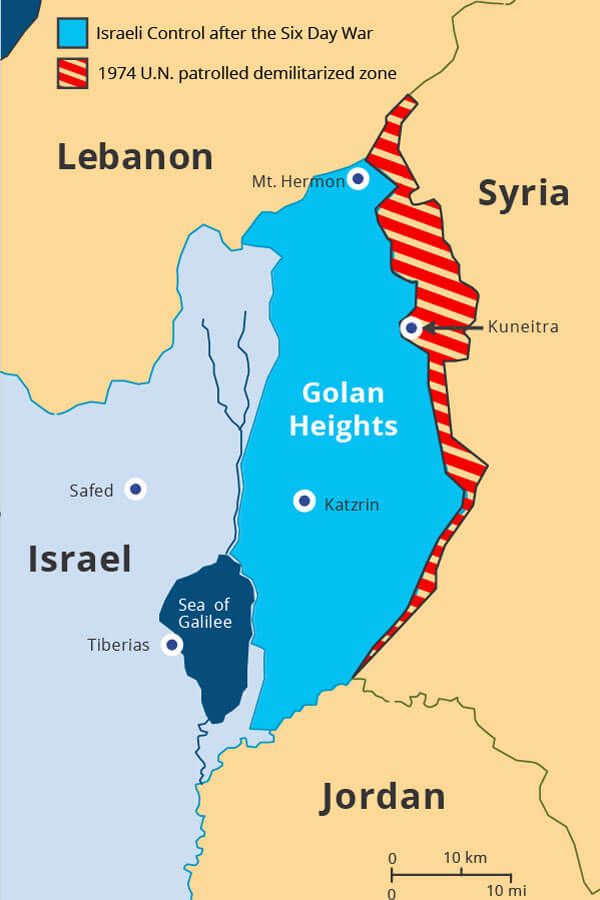Land for peace has been the central mantra in the decades-long quest to resolve the conflict between Israel and its Arab neighbors.
In the context of the Israeli-Arab conflict, the concept first originated in the diplomatic arena of the United Nations in 1947. UN Resolution 181, better known as the Partition Plan, called for allotting land for the peaceful creation of two countries, Jewish and Arab.
Resolution 181 was accepted by the Jews but rejected by the Arabs, who declared war in a bid to prevent the creation of the Jewish state. Although the UN failed to implement 181, that first diplomatic solution to the conflict was the original two-state solution, a concept that only came back into vogue in the wake of the Six-Day War in 1967.
Join the fight for Israel’s fair coverage in the news
Key Diplomatic Semantics
In the 1960s the world tended to talk about the “Arab-Israeli” conflict in terms of the tiny Jewish state surrounded and vastly outnumbered by its Arab neighbors. That conflict climaxed in 1967 when Arab countries failed to fulfill their goal of driving the Jews into the sea. The result of the Six-Day War was an Israeli military victory and the capture of the West Bank from Jordan, the Sinai Peninsula from Egypt and the Golan Heights from Syria.

After the war there was a major diplomatic effort, the result of which was the creation of a new standard when the UN unanimously adopted Security Council Resolution 242. Its wording was crafted carefully in order to make the resolution palatable to all sides, and contained the key phrase: “Withdrawal of Israel armed forces from territories occupied in the recent conflict.”
The short, but very significant document became the cornerstone for future negotiations. Those unfamiliar with the semantic nuances of 242 unilaterally change the wording to “the territories” and wrongly conclude it means all territories. However, the resolution’s author, British diplomat Sir Hugh Foote, also known as Lord Caradon, emphatically pointed out that the Security Council members passed 242 unanimously with full knowledge of the intentional wording
“It would have been wrong to demand that Israel return to its positions of 4 June 1967 because those positions were undesirable and artificial,” Caradon said.
Land for Peace in Practice
Since 1967 there have been several Israeli withdrawals from lands occupied by its military, the two most noteworthy being:
1. Peace Treaty with Egypt (1979): Following the historic first peace agreement with an Arab neighbor, Israel removed its 18 settlements and three IDF bases in a staged withdrawal over three years from the strategic Sinai Peninsula it captured in the 1967 war. The two countries have been at peace ever since, going so far as cooperating militarily in the fight against Islamic terrorism in the Sinai.
2. Peace Treaty with Jordan (1994): The two sides resolved some minor border issues and Jordan absolved itself of any sovereignty claims over the West Bank. Israel leased some area in the Jordan Valley, but the two resolved all land claims. That ended in late 2019 when Amman refused to extend the leases.
The treaties with both Egypt and Jordan specifically mention that Resolution 242 is a basis of the peace.

Unilateral Withdrawal Does Not Lead to Peace
Peace activists and diplomats have repeatedly put forth the argument that peace between Israel and the Palestinians could be obtained ‘if only Israel would simply leave the occupied territories.’
Similar arguments were made at the end of the 20th century with calls for Israel to withdraw from Lebanon, in the “hope” that the result would be to “move ahead in negotiating peace treaties.”
Two stark examples prove the fallacy of the argument:

1. Withdrawal from Southern Lebanon (2000): As the second intifada raged, Prime Minister Ehud Barak ordered the withdrawal of the IDF from Lebanon. Israel’s war in Lebanon began in 1982 in response to terror attacks from Lebanese territory and a breakdown in law and order as Lebanon’s civil war raged.
Instead of the UN’s goal of seeing the government of Lebanon “deploying its armed forces throughout southern Lebanon,” the land was taken over by the Iranian armed and financed Hezbollah terror organization. Hezbollah subsequently refused to implement the toothless UN Security Council resolution 1701 that called for it to be disarmed and absorbed into the Lebanese army.
Strengthened by Israel’s withdrawal, years later Hezbollah would play a key role in helping Syrian dictator Bashar Assad brutally crush the civil war that started with unarmed Syrian civilians demonstrating to demand more human rights.
“The unilateral withdrawal from Lebanon did in fact boost Israel’s image in the international arena but severely harmed Israel’s image in the region,” wrote Shmuel Even of the Institute for National Security Studies (INSS) in Tel Aviv. With no negotiation between sides, Even says the expectation was “the withdrawals would create a new political reality that would promote the peace process.” However, the new reality that was created “strengthened the opponents of peace in the region.”
2. The Gaza Disengagement (2005): Under the government of Prime Minister Ariel Sharon, known as a staunch right-winger and the “bulldozer” who pushed settlement construction, Israel arbitrarily withdrew its settlements and army bases from the Gaza Strip and handed complete control over to the Palestinian Authority. Sharon explained that “there exists no Palestinian partner with whom to advance peacefully toward a settlement” and, therefore, Israel must take unilateral action to address the conflict with the Palestinians.
Within two years the Hamas terror group staged a bloody military coup and seized power. Hamas remains committed to its goal of using military force to replace Israel with an Islamic Palestinian state. Gaza is under blockade because of the threat of weapons smuggling.
Related reading: The Gaza Blockade: An Explainer
Israel’s withdrawal from the land in Gaza resulted in the opposite of peace: there have been several wars initiated by Hamas. Hamas not only does not embrace the concept of “land for peace,” the military dictatorship that runs Gaza with an iron fist emphatically rejects the peace process and is backed by Iran, which repeatedly calls for the “total annihilation” of Israel.

Israeli withdrawals from Lebanon and Gaza prove the fallacy that simple withdrawal by Israel will fulfill the “hope” of diplomats and lead to peace. To date, successful land for peace requires state actors, with no indication that non-state actors have the ability to fulfill the concept.
Land for Peace and the Two-State Solution
It is important to note that in 1967 “land for peace” meant peace with Jordan, Egypt and Syria, but not with an independent Palestinian state. At the time, the Palestine Liberation Organization was not a state actor and called for the destruction of Israel and replacing it with a Palestinian state. Resolution 242 only called for a “just settlement of the refugee problem.” There was nothing about a two-state solution that was only talked about again when secret talks led to the Oslo Accords.
 The reality in the 21st century is that the Arab-Israeli conflict has faded away. The concept of land-for-peace was an integral part the peace Israel has with two of its formerly belligerent neighbors. The third key party, Syria, remains in a state of chaos and instability, consumed with its internal problems – peace with Israel is not on its agenda. In 1981 recognizing Syrian dictator Hafez Assad’s rejection of peace, Israel passed legislation applying Israeli law to the Golan Heights. Although stopping short of annexation, the door on land for peace with Syria was closed by the combination of the breakdown of Syria and the 2019 recognition by the United States of Israeli sovereignty there.
The reality in the 21st century is that the Arab-Israeli conflict has faded away. The concept of land-for-peace was an integral part the peace Israel has with two of its formerly belligerent neighbors. The third key party, Syria, remains in a state of chaos and instability, consumed with its internal problems – peace with Israel is not on its agenda. In 1981 recognizing Syrian dictator Hafez Assad’s rejection of peace, Israel passed legislation applying Israeli law to the Golan Heights. Although stopping short of annexation, the door on land for peace with Syria was closed by the combination of the breakdown of Syria and the 2019 recognition by the United States of Israeli sovereignty there.
Other Arab countries including Morocco and many of the Gulf states have informal ties with Israel. They openly push for cooperation, recognizing themselves that land for peace will not work given the current Palestinian situation. Most Arab countries have greatly scaled back their anti-Israel rhetoric, paying only lip service to the standard call for “Israeli withdrawal from occupied territories.”
Related reading: Israel-Saudi Ties in Focus
As former enemies warm to Israel, the conflict is morphing from a regional one to what is more frequently called the Israeli-Palestinian conflict. A bigger obstacle to peace isn’t Israel’s obstinacy on land for peace but the entrenched divisions between the Fatah-controlled Palestinian Authority in the West Bank and the Hamas-run Gaza Strip. Divided Palestinian rule makes headway on peace efforts impossible.
“The events of recent years have eroded the relevance of territorial withdrawal as an agreement-promoting move,” wrote Zaki Shalom of the INSS. “The ‘land for peace’ formula, a mantra in the State of Israel since the Oslo accords, lost its appeal and practicability among many…”
Conclusion
Given the complex nature of the conflict, the peace process cannot be dumbed-down to a simple mantra of “land for peace.”
The concept is valid when two sides negotiate in good faith, as with Egypt and Jordan. But peace efforts also require a negotiating partner that can make and implement peace moves in both the West Bank and Gaza.
The crisis of divided Palestinian leadership has existed since 2007. As long as this deadlock remains, land for peace will certainly be a non-starter.
Liked this article? Follow HonestReporting on Twitter, Facebook, Instagram and TikTok to see even more posts and videos debunking news bias and smears, as well as other content explaining what’s really going on in Israel and the region.
Featured image: vectors by Freepik; Klos C via YouTube/”Yerushalayim” – TV magazine in Russian about Israel;


